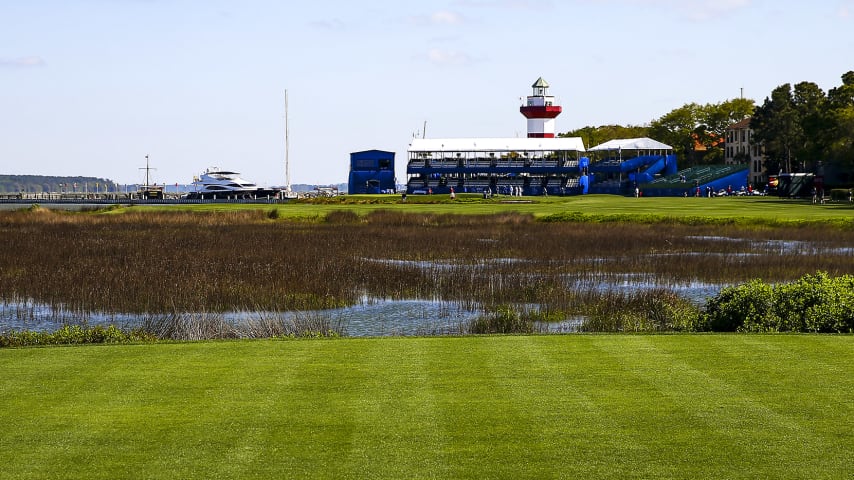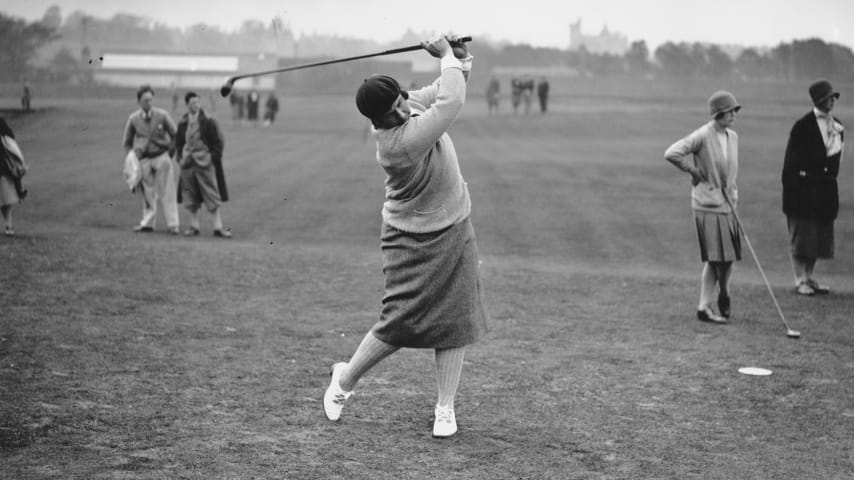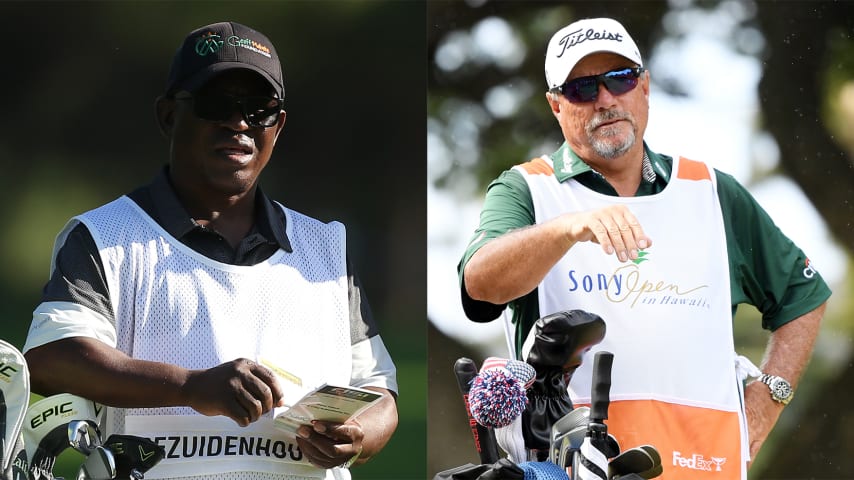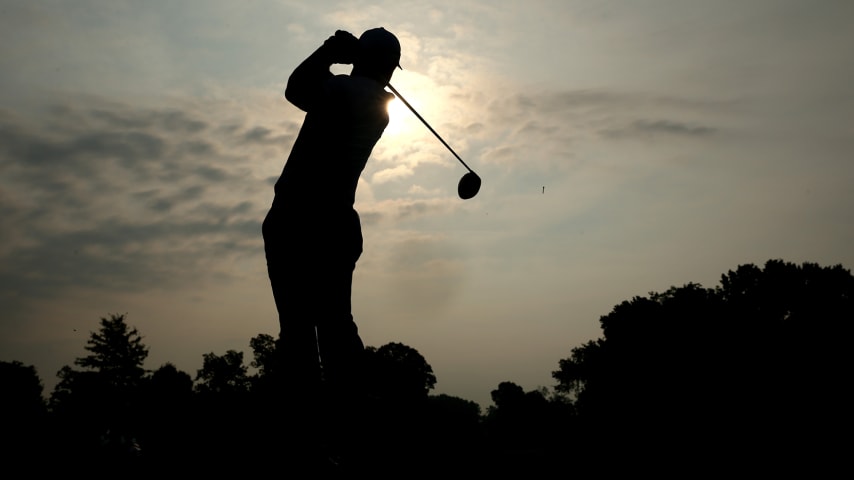Nicklaus + Dye = ‘work of art’
11 Min Read

HILTON HEAD ISLAND, SC - APRIL 16: A general view of the 18th hole during the RBC Heritage Pro-Am at Harbour Town Golf Links on April 16, 2014 in Hilton Head Island, South Carolina. (Photo by Streeter Lecka/Getty Images)
The inside story of how two Ohio golfers collaborated to create Harbour Town, a true masterpiece
Written by Jim McCabe
The inside story of how two Ohio golfers collaborated to create Harbour Town, a true masterpiece
You have a better introduction to a golf course and a PGA TOUR tournament than what took place within the cozy confines of Sea Pines Plantation on Hilton Head Island in 1969?
Go ahead, we’ll wait.
Then again, we won’t. Case closed, probably a 10-and-8 decision. Arnold Palmer winning on a sparkling new layout co-designed by Jack Nicklaus and chronicled by Dan Jenkins takes the prize.
“JACK’S COURSE IS ARNIE’S, TOO,” was the brilliant headline that Sports Illustrated editors chose to affix over words typed by the esteemed Jenkins, whose prose, no surprise, still resonates:
In a dolled-up swamp off the coast of South Carolina’s low country and on an island with more dripping moss and crooked magnolias than you would find in a dozen Civil War novels, Jack Nicklaus made his debut as a golf-course designer last week before the toughest possible audience – his fellow touring pros. These included his friendly rival, Arnold Palmer, who seized the occasion to show Jack and everybody else how the magnificent course ought to be played.
Not a bad little trifecta – Palmer, Nicklaus, Jenkins – to usher us into the history of that corner of the golf world, originally scheduled to host this week’s stop on the PGA TOUR schedule, the RBC Heritage, for a 52nd straight year.
But to apply even greater flavor to the story of the introduction of Harbour Town Golf Links, digest the fact that a fourth name factors in the story.
Pete Dye, who years later would concede that “Harbour Town made my career.”
In 1968, the quest to build a championship course with “an old-fashioned look” was explored by Charles Fraser, the dynamic force behind Hilton Head Island wanted a “name” to attach to his project. The man, after all, understood marketing.
Fraser directed his inquiry to Mark McCormack, the head of IMG, who in turn suggested Nicklaus, then 28 and with seven of his 18 majors already in hand. Intrigued by the idea, Nicklaus conceded to Fraser that “I really no idea what to do with a golf course at that time,” but he knew someone who did.
Pete Dye.
“Never heard of him,” said Fraser.
That’s OK, because Nicklaus was quite familiar with him. As Ohioians – Dye was from Urbana, Nicklaus from Columbus – who loved golf, they had crossed paths competitively. At the 1958 Trans-Mississippi Amateur, Nicklaus, then 18, beat Dye, then 32, in the semifinals. Years later, Dye was building The Golf Club in Columbus and wanted some input from Nicklaus, a rising force in pro golf.
“I was reluctant to do so at first,” Nicklaus once said, but when he agreed, a spark was ignited. He enjoyed the experience and the men agreed that there would be another collaboration.
Enter the opportunity at Harbour Town. Fraser took stock in Nicklaus’ recommendation, Dye was brought into the project -- and the rest, as they say, is history. A brilliant history, as the course combines Dye’s vivid imagination and Nicklaus’ golf acumen and is a showcase stage for what might just be the coziest week on the PGA TOUR schedule.
Harbour Town Golf Links is one of just five current courses to be used annually for PGA TOUR tournaments for more than 50 years (Fort Worth’s Colonial dates to 1946; Pebble Beach to 1947; Waialae in Honolulu to 1965; Torrey Pines to 1968), which makes this week’s cancellation of the RBC Heritage a somber experience in this enchanting community of warmth and hospitality.
To talk of Harbour Town and its rich history helps soften the pain.
Dye was 43 and had fewer than 10 designs on a resume that eventually earned him induction into the World Golf Hall of Fame when on Thanksgiving Day in 1969, he was more interested in comments and reaction than turkey and stuffing. Round 1 of the inaugural Heritage Golf Classic was being contested on this glistening seaside layout that Dye and Nicklaus had created with land that was, to put it mildly, an engineering challenge.
Dye was prepared for players’ criticisms. Not to be combative (he had thick skin) but to see if his suspicions were correct.
In his autobiography, “Bury Me in a Pot Bunker,” Dye wrote: “Tour professionals accustomed to lavish fairways and large greens found my deceivingly narrow fairways and small greens difficult to play and many seemed displeased with the new course.”
Turns out, moans and groans did surface. No surprise, given that through the first two rounds, there were 39 scores of 80 or higher.
But what drowned out the dissenters were Sunday cheers from fans as Palmer avoided his first winless season as a pro in the season’s third-to-last tournament. (For good measure, he won the next week, too, in Memphis.)
And what easily helped deflect the critiques was the game’s best player, Nicklaus, staking his reputation to the fairness and quality of this golf course. A dominant power player, Nicklaus had helped create a golf course that rewarded “smart golf,” as he put it.
The one-two punch of Palmer and Nicklaus (who finished T-6 on 71-71-71-75) provided a glowing stamp of approval good enough for Jenkins, who wrote:
Harbour Town is some golf course, folks, just about the best new course that anyone has built in ages.
More than a half-century later, it remains just as magnificent; arguably it is the best of Dye’s long list of great works. The famed architect, who died Jan. 9 at the age of 94, had never understated how important Harbour Town was to his career, and he never failed to educate those who suggested Nicklaus was just a consultant. Dye championed Nicklaus’ huge input and left Harbour Town with a lifetime friend, indebted to what the golfer meant to him.
“To have this respected champion associate with me was an enormous boost to my confidence,” Dye wrote in his book. “I will always be grateful to Jack’s belief in me.”
Often overlooked in the Harbour Town saga is the sheer chance that a tournament could even have been held in November of 1969. Good gracious, the project had been officially christened on July 2, 1968, and construction was barely underway when, on Oct. 3, Fraser’s seemingly wild pitch to host a PGA TOUR tournament on Hilton Head Island was accepted. (Just 20 years earlier, barely a few hundred people lived there.)
These were new days in pro golf, too. The American Professional Golfers Association officially split from the PGA of America, thus would 1969 be considered the first full schedule under the control of the PGA TOUR and new commissioner Joe Dey. That the tournament at Sea Pines was one of the first tournaments to sign on is another layer of rich flavor to this annual happening.
Fraser’s announcement was news to Dye, of course, but he never was known to hit the panic button. He accepted the sense of urgency and pushed forth.
The course was originally targeted to open in the spring of 1968, but by Nov. 9, 1969 – less than three weeks from the start of the tournament – just two golfers had played it: Nicklaus and Dye.
Nicklaus was proactive. He was with Dey in early November, checking out options should Harbour Town not be ready, even as Dye was asking his wife Alice to figure out what to do with the 13th green. Sea Pines’ other two courses, Ocean and Marsh, were surveyed and deemed acceptable, but the new commissioner was unwavering in his support of Harbour Town.
Media reports in the days leading up to the Nov. 24 start were similarly glowing. “To top things off,” read a story about the Dye-Nicklaus collaboration in the Palm Beach Post, “a special crew of 10 men will soon start examining every inch of the 150-acre layout to repair any blemish that might have been overlooked – such as a weed.”
Though he wasn’t involved in the Harbour Town story, Bill Coore has an intimate understanding of the golf course-building business and as someone who later worked for Dye, he cherishes all the subplots: Fraser’s push to host a tournament, the valuable input of the game’s best player, more testament to Alice Dye’s marvelous legacy (“She was integrated, way more than people realize; she had great ideas,” he said), but most of all the significance of Harbour Town in the big picture.
“I have always said that Pete deserves enormous respect for changing the direction of golf course design twice in his career,” said Coore, who together with Ben Crenshaw has given the golf world a parade of majestic golf courses.
TPC Sawgrass in the 1980s, said Coore, ushered in an era of big, fan-friendly, stadium venues. But the first great change had come when Dye assessed the style of golf courses back then – wide fairways and big, sweeping bunkers, trees and greens – “and deliberately went in the other direction with tighter fairways, smaller bunker, smaller greens.”
To that mix, Dye offered golfers a look they had rarely seen. Wrote Jenkins:
A brutally narrow, abruptly twisting tangle of brooding pines, oaks, palmettos and magnolias. Hit the ball just slightly offline at Harbour Town and you need Sheriff Rainey and them dogs to go fetch it.
Said Dye: “Harbour Town just jumped out of the woods.”
Nicklaus told reporters: “We cleared this one pretty much with silk gloves. You know, it’s not easy to replace a 100-year-old tree.”
Mind you, these thoughts and explanations were delivered 51 years ago, but guess what? The glory of Harbour Town still shines like a beacon and recent winners of the RBC Heritage are in harmony with Dye and Nicklaus and Jenkins. Some tight and tidy descriptions of a course that is beloved for its tight and tidy persona:
“Test of ball-shaping, positioning and patience,” said Graeme McDowell, the 2013 champion.
“Small greens, tight fairways, wind,” said 2011 winner Brandt Snedeker.
“Timeless Dye masterpiece,” said Brian Gay, author of a stunning 10-stroke victory in 2009.
McDowell (10 starts), Snedeker (14) and Gay (19) are players who cherish Harbour Town and the annual RBC Heritage and consequently attend faithfully. They are not alone, because while it’s difficult to quantify, the RBC Heritage might possess the strongest sense of loyalty among elite PGA TOUR members.
“I think 100% of the guys want to be here,” Snedeker said, and oh, how they came – Davis Love III 30 times, Hale Irwin 26, Tom Watson 25, Hubert Green 23, Nick Price and Jim Furyk 20 each, Ernie Els 19, Nick Faldo 18, Greg Norman 17.
When he won, McDowell gushed with pride to know he had joined illustrious company (Palmer, Irwin, Johnny Miller, Watson, Nicklaus, Green, Payne Stewart, Fuzzy Zoeller, and Furyk) as U.S. Open champions to win at Harbour Town.
The glory of this layout hard by Calibogue Bay manifests itself is another spin of the roll call of champions. In the first 35 years, the tournament was won 22 times by 12 future Hall of Famers – Palmer, Irwin (3), Miller (2), Nicklaus, Green (2), Watson (2), Faldo, Bernhard Langer, Love (5), Norman, Stewart (2), and Price.
Convincing testimony to Harbour Town’s reputation as a course that puts a premium on ball-striking and shot-making, ingredients that stir the fancy of any golf fan.
But, still, it is the aura of Dye that is felt when you play, or even walk, this course. Trees hug fairways and induce you to hit shots to the wrong spot; sharp, crisp bunkers; tight doglegs; the U-shaped green at No. 9; the confounding and twisting par-5 second; the beguiling and twisting par-5 15th; then that brilliant transformation from the cozy walks on the back nine to the breathtaking and windswept seaside vistas of the dogleg par-4 16th, par-3 17th; and par-4 18th completed by the iconic lighthouse.
What speaks to Dye’s character is the way he showered praise upon those who spent so much time with him at Harbour Town in 1968-69.
“Jack Nicklaus was always there to voice an opinion,” Dye wrote in his book, “especially for what I wanted to do with the shorter holes (which are the heart and soul of Harbour Town) he was helpful and sensitive.”
As to the famed 13th, a short, par 4 where the approach is to a green protected by an expansive bunker shaped liked a horseshoe, with cypress-boards used to prop up the green. Legendary is the story Dye related while walking and observing the first round of the Heritage Golf Classic in 1969, how he heard two fans talking about “Nicklaus’ design” of that bunker.
Dye apologized for interrupting but told them that “a very lovely lady designed and built this hole,” then went on his way. But not before hearing one of the men tell his friend: “Well, there’s an early-morning drunk for you.”
The story has always been good for hearty laughs, because it’s true and because it speaks to Dye’s legacy and how he just didn’t go by plans. He went by getting into the dirt and trusting his gut, then turning to others for suggestions.
The fact that Nicklaus trusted his gut and insisted Fraser bring Dye aboard, then followed his instinct and studied intently under a man he considered to be a visionary and friend … well, the end result was a brilliant collaboration producing an instant classic.
Wrote Jenkins:
In an era when architects for some reason enjoy giving us 7,000-yard courses with greens the size of a supermarket parking lot, Nicklaus and his partner, Pete Dye, have done the opposite. They have used great imagination and given us nothing short of a work of art.
That was then. And still is now.





